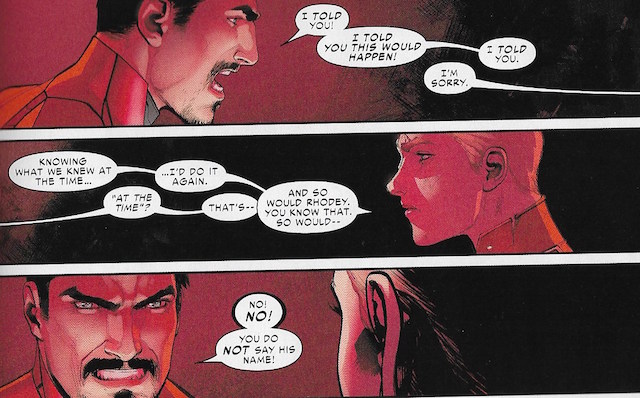Tag: Carol Danvers
Civil War II No. 7 perfectly explained by Miles Morales: ‘This is weird. Even for people like us’
Brian Michael Bendis’ Civil War II #7 is finally out, although the “summer” event still has one more month to go. On deck is Marvel’s Inhumans vs. X-Men. If you want to know what the company’s obsession with hero vs. hero tales means for our cultural mosaic, then check out my latest YouTube video below.
If you like what you see, then make sure to subscribe for future reviews. And, as always, let me know what you think in the comments section below.
Civil War II #5: Team Stark v. Team Danvers throw down

Brian Michael Bendis’ Civil War II #5 hit stores this week, and someone must have slipped something in his drink because he dedicated the entire issue to a massive brawl between Team Stark and Team Danvers. Is that a good thing? A bad thing? You’ll have to check out my latest YouTube video to find out.
After you’re done watching, let me know what you think in the comments section below — particularly you’re thoughts on the Inhuman Ulysses’ latest vision.
Bendis nicely sets up ‘Champions’ in Spider-Man #8, but classic heroes turned into giant goofs
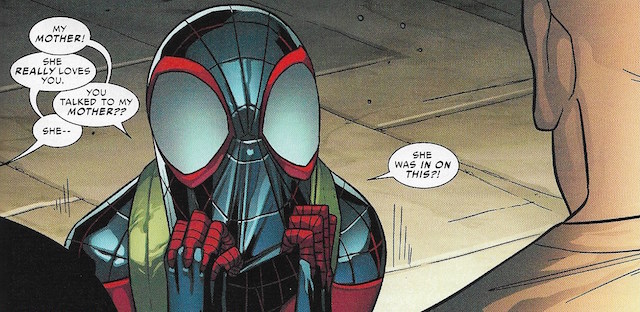
Brian Michael Bendis is one of Marvel’s key writers, but in a previous life he may have been a circus juggler. Spider-Man #8 somehow manages to move the title’s plot forward, set the stage for Champions, and seamlessly tie into Civil War II. Technically, Mr. Bendis hits all of his marks. Creatively, however, SM #8 once again shows why many older Marvel fans are fed up with the company.
Here is what you need to know for SM #8:
- Jessica Jones and Luke Cage confront Miles Morales on a rooftop and say they know his secret identity.
- Miles is upset to find out that his grandmother hired Jessica Jones to spy on him, but he is glad to hear that his mother tried to pay the investigator to cancel the contract. He agrees not to say anything to his family after the older heroes tell him to get his act together.
- Miles is summoned to the Triskelion, S.H.I.E.L.D. headquarters, by Tony Stark. A large group of superheroes are informed by Stark and Captain Marvel that everyone will confront the Hulk about Ulysses’ vision of him killing everyone.
- Bruce Banner is killed by Hawkeye, as previously shown in Civil War II #3.
- Nova, Spider-Man, and Ms. Marvel are stunned by what happens and the two young men publicly state their allegiance to Tony Stark. Ms. Marvel breaks down into tears because her role model set the stage for Banners’s death.
This sounds like a great issue, right? Well, sort of. One’s enjoyment or hatred of SM #8 really hinges on his or her opinions on Civil War II. Bendis — and artist Nico Leon — do an admirable job showing young heroes who struggle to find their place in an “adult” world, but at the same time it all comes at the expense of classic characters.

There is a scene after Banner’s death where the three kids come together to comfort one another that is incredibly poignant, but the feeling disappears the moment one realizes that Captain Marvel and every superhero who sides with her has taken on a goofy position to make Civil War II work.
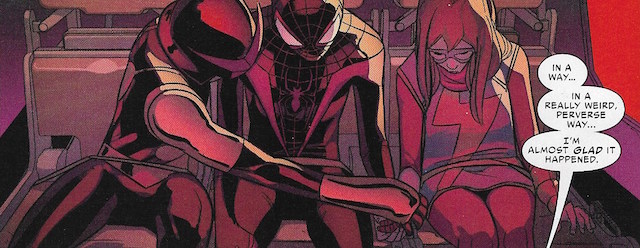
In short, Mr. Bendis has nicely set up an “us against the world” dynamic for the future “Champions” that will also serve Spider-Man well, but in many ways he is doing so at the expense of icons like the original Spider-Man, Peter Parker.
If you are an older reader, the best way to show your displeasure is to withhold your wallet for any title that engages in character assassination of the heroes that made Marvel what it is today.

‘Civil War II: Amazing Spider-Man #4’: Dan Slott’s ASM #17 haunts Christos Gage’s latest effort

It’s hard not to feel sorry for Christos Gage. The guy was asked to write a Spider-Man story that stood on its own while also supporting Brian Michael Bendis’ Civil War II and Dan Slott’s run on The Amazing Spider-Man.
Question: How does the hero who a.) asked The Prowler to resort to corporate espionage on behalf of Parker Industries, and b.) teams up with Carol “Minority Report” Danvers have the moral authority to lecture a confused man like Clayton Cole?
Answer: He doesn’t.
Civil War II: Amazing Spider-Man #4 is a book that actually reads better the less one knows about the current Marvel universe. For people who just want to roll around a few philosophical questions about redemption and free will like marbles, Mr. Gage’s work satisfies. For people who love the character Peter Parker, however, the issue is just one more reminder of just how intellectually discombobulated he has become thanks (in large part) to writer Dan Slott.
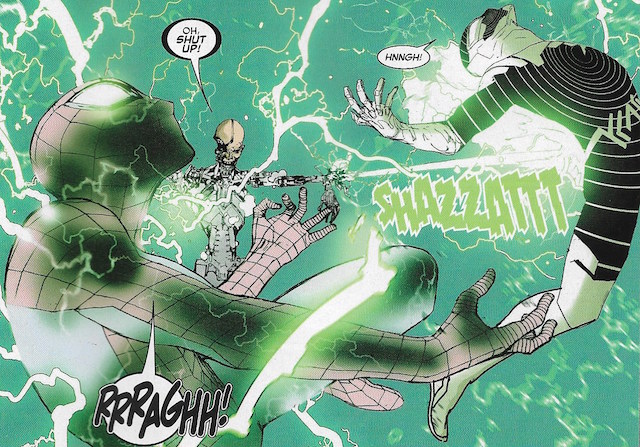
Here is what you need to know for CWII: ASM #4:
- Spider-Man tries to talk Clayton Cole off a psychological ledge during the one-on-one battle predicted by Ulysses. Peter wants the scientist to give up his “Clash” technology and start a new life.
- Robot Master reconstitutes himself and attacks the two men just as Peter seems as though he might have a breakthrough.
- Clayton leaves Spider-Man to deal with the villain on his own, saying that he needs to go his own way.
- Spider-Man defeats Robot Master, who vows to take Parker Industries to court for Cole’s attack.
- Peter Parker and Ulysses discuss the Inhuman’s powers, whether they are appropriate to use, and how to channel them to save lives. Peter now says it would be wrong for Ulysses to work for Parker Industries because the company will be stronger by learning from its own from failures.
- Spider-Man agrees to work with Carol Danvers to profile potential future criminals. He will fight for the cause if necessary, but says he will act like her personal Jiminy Cricket (It worked out so well with Doctor Octopus, right Pete?)
- Clash steals a massive amount of off-the-books cash from Roxxon and announces that he will no longer work for other men. The villain begins to recruit for a criminal empire.
Fact: Clayton Cole wanted to “redefine” himself as a hero using Clash technology.
- What then, we must ask, gave Spider-Man the moral authority to say that Clayton Cole should not do that, but Hobie Brown as the Prowler can?
- Why is Dan Slott’s Peter Parker a stand-up guy for asking Mr. Brown to break into a business and steal technology for his own selfish reasons, but Mr. Cole is “ruining” his life for trying to turn over a new leaf as Clash — the superhero?
- How can Peter Parker, a man who has been falsely convicted in the court of public opinion multiple times, endorse Captain “secret detention” Marvel?
In short, CWII: ASM #4 is filled with creative contradictions, which are not treated as such. As was stated in previous reviews, it is tough to discern how culpable Mr. Gage is for the story’s flaws when a strong argument can be made that he is doing the best he can with messes made by other men.

If you have read the previous three issues of Civil War II: The Amazing Spider-Man, then you may as well buy the conclusion. If you have held off this long, then skip it and take note: The modern Spider-Man is like a boat without an anchor in a storm that shows no sign of breaking.
Again, I feel bad for Mr. Gage — but even more so for the writer who eventually replaces Mr. Slott. Where does a man begin with so much rubble to clear? I guess we’ll find out.

Related:
‘Civil War II: Amazing Spider-Man #1’: Gage offers reprieve from Slott fare
Civil War II No. 4 Review: Captain Marvel learns to love the police state
Civil War II #4 is out, which means that it’s time for another review on Marvel’s latest hero vs. hero event. Check out your friendly neighborhood blogger’s latest Youtube video and share your thoughts in the comments section below!
Civil War II # 3: Bruce Banner goes out like a punk during superhero amateur hour
Marvel’s Civil War II #3 was released today, which means Bruce Banner is officially dead (until he’s alive again). Your friendly neighborhood blogger might do up a write-up in the future, but I figured the occasion offered a good excuse to experiment with uploading my first real YouTube review.
Civil War II #2: ‘Torture’ Stark duplicates dumb mistakes from 2006

It was one month ago that this blog asked if Marvel’s Civil War II would avoid the kind of mistakes made during 2006’s first Civil War event. Mark Millar and others turned Tony Stark into a Dick Cheney-esque villain to forward an embarrassing Bush administration allegory, and as a result the story tanked. Brian Michael Bendis has seemingly learned nothing in ten years. His Tony Stark jokes about torturing others “a little bit” in scenes that are unnecessary in terms of moving the plot forward.
Here is what you need to know for Civil War II #2:
- Tony Stark goes to New Attilan and kidnaps Ulysses. An Iron Man decoy defeats Medussa and Karnak while the real Tony escapes to a secret location.
- The Inhumans head to Stark Tower. Karnak vows to tear it down when S.H.I.E.L.D., Captain Marvel and the rest of The Ultimates appear.
- Captain Marvel wants “one chance” to get Tony under control.
- Tony hooks Ulysses up to a brain scanner and threatens to beat him to see how the young man’s brain waves affect his precognition.
- Friday downloads a “copy” of Ulysses’ brain just before the other heroes locate Tony Stark and confront him.
- Ulysses says Tony tortured him, and the billionaire’s response with a smile is, “a little bit,” (because torture is supposed to be funny?).
- Ulysses has a vision that the Hulk kills all the heroes, but this time the episode is seen by everyone in the room.
- Captain Marvel arrives at Bruce Banner’s lab in Alpine, Utah.
While one can debate the definition of torture all day, it is much harder to deny that the scene in question was unnecessary. It only serves to make Mr. Stark look unhinged.
Ulysses even says, “You could have asked me to do these tests,” to which Tony says nothing. There is no response because Tony Stark, even while grieving for his friend, would have demanded an opportunity to study the kid’s brain.
Given that Ulysses has said he is (or was) a huge fan of Tony Stark, and given that the Inhumans let him web-sling around New York City with Spider-Man, it’s a safe bet that they would have allowed him to wear a few brain scanners. There is no reason to engage in character assassination in order to tell a good story, but for some strange reason Marvel likes turning Tony Stark into something from CIA leaker Edward Snowden’s worst nightmares.

Stark’s CIA black site tactics are then juxtaposed with the measured diplomacy of female heroes. Bendis writes a scene that screams, “Imagine if the world were run by women — there would be no more wars! They would look into each other’s eyes, connect with universal sisterhood of things, and come to an agreement. Darn those…those…men!”

The problem with hero versus hero events is that it is obvious that Marvel’s current staff does not know how to write a legitimately balanced story. The Russo brothers proved that it can be done with Captain America: Civil War, but for some unknown reason the comic book scribes are incapable of such a feat.
The result, sadly, is that readers think, “These guys are dysfunctional losers. The world would be better off without them. Why should I buy this?”
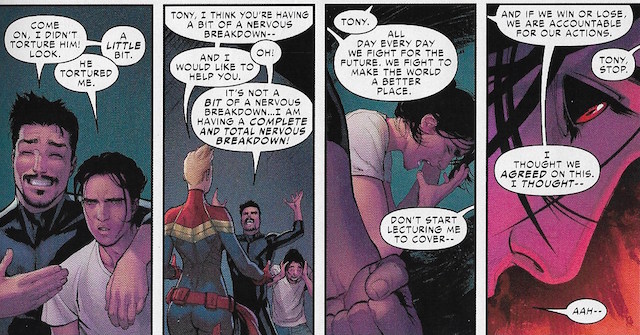
Civil War II could have been an intriguing tale, but turning Tony Stark into “Torture” Stark does not bode well for future issues. Perhaps Bendis will right the ship, but as of now it looks like it’s the captain who is trying to sink his own vessel.

Civil War II #1: Rhodey’s death a missed opportunity

Marvel Comics’ Civil War II officially kicked off on June 1 with James Rhodes … kicking the bucket. Fans were given a hint of his fate in late may with Civil War II #0, but writer Brian Michael Bendis and artist David Marquez made sure by the end of the first issue that everyone knew War Machine just saw his last* battle. It is hard not to believe, however, that killing Rhodey instead of pitting him against his best friend over a complex issue was an error on Marvel’s part.
Here is what you need to know for Civil War II #1:
- A huge cast of superheroes square off against a Celestial Destroyer. A tip by The Inhumans allowed Iron Man, Dr. Strange, Captain Marvel and the others to devise a plan that would send the entity to its home dimension.
- Tony Stark throws a party for the “unqualified, top-to-bottom home run of a win.” The mood is spoiled when it is revealed that Ulysses, an Inhuman who “experiences” the future, was the one who provided intelligence on the Celestial Destroyer’s arrival.
- Captain Marvel asks Ulysses if he wants a job with The Ultimates after Jean Grey fails to read his mind. Tony Stark wants nothing to do with the young man. He warns everyone that using Ulysses’ power to confront people over a possible future is dangerous and wrong.
- Ulysses has a vision of Thanos coming to earth and tells The Inhumans to contact Captain Marvel.
- The events of Civil War II #0 unfold. She Hulk is greatly injured and Rhodey dies.
- Tony confronts Carol Danvers, aka Captain Marvel. She tells Tony what happened and his is livid. “I told you! I told you this would happen!” he screams. Carol says she did the right thing and that Rhodey would act no differently if he had it all to do over again.
- Tony storms off to “make sure none of [the superheroes] play God again.” She Hulk wakes from a coma and tells Captain Marvel to fight for the future (“It’s our future, Carol. Not his.”) before her heart stops. Doctors try to revive her and the issue ends.
The good thing about Marvel’s decision is that there are plenty of legitimate arguments to be made for killing Rhodey. Unlike turning Steve Rogers into a Nazi-sympathizing Hydra Agent, James Rhodes’ integrity was not violated in the decision-making process. Soldiers die. Every time a warrior steps onto the battlefield, he knows that he might not live to see another day. That’s just how it works.
The bad thing about Marvel’s decision is that it robs readers of a chance to see two friends battle over fierce ideological differences while ultimately finding peace in the end. Both Tony and James would respect the other’s willingness to die for core principles, and in the long run their friendship would probably be stronger for having gone through the ordeal.
A standoff between Tony and Carol has the potential to be powerful, but the better choice would have been Tony vs. James.

In short, Civil War II appears as though it will be a good read if Marvel finds a way to avoid the mistakes of Civil War I (e.g., inserting partisan politics in the story to make on side look evil). It’s just unfortunate that Bendis missed an opportunity to dial up the dramatic tension by keeping Rhodey alive.
*“Last battle” until a Cosmic Cube, a magical gem, or a spell brings him back to life.
